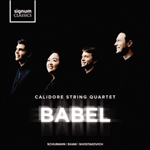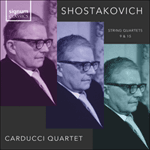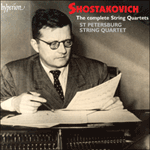
Welcome to Hyperion Records, a British classical label devoted to presenting high-quality recordings of music of all styles and from all periods from the twelfth century to the twenty-first.
Hyperion offers both CDs, and downloads in a number of formats. The site is also available in several languages.
Please use the dropdown buttons to set your preferred options, or use the checkbox to accept the defaults.
Despite these connexions, the Ninth differs in that the greatest weight is thrown on to the last movement. There are other, closer connexions between Nos 8 and 9, notably thematically and rhythmically, which are sometimes combined. Another important point concerns the tonal basis of No 9. In choosing E flat major as the ‘home’ key, which (without going into too great a detail) it would have been difficult for Shostakovich to avoid in this context, E flat is the relative major of C minor, the pervasive tonality of the ‘suicidal’ Eighth, and half-way between the Seventh’s F sharp and the Eighth’s C minor. What is unusual in the Ninth is Shostakovich’s almost psychotic avoidance of C minor in the first four movements. It is as though the E flat of his third wife’s quartet has removed the suicidal tendency implicit in the tonal relationship between the relative keys of E flat major and C minor, until in the finale he confronts the problem head-on.
The quartet opens with a thematic exposition over a long-held octave-pedal E flat on viola and cello, second violin oscillating scalically through a diminished fifth (initially C and G flat, later G and D flat). Within the first five bars of the work, Shostakovich causes us to glimpse a vast harmonic panorama against which the musico-dramatic events will be played out. The basis for such an observation is not crystal-clear; there is a misty (not mysterious) atmosphere to the music, as the first violin’s initial theme plants A within an E flat context (another diminished fifth). Clearly, for those with ears to hear, we may have a long way to go.
But nowhere in this music—indeed, as it is probably true to claim in his entire output—is Shostakovich either uncertain in his aims, or unable to take sympathetic listeners with him. If the ‘personal’ background to this quartet remains a private matter, a message in code, the music throughout makes profound sense as music. Thus the tonal implications of the opening bars, to say nothing of the profoundly symphonic development of the tiny motifs which make up the thematic and intervallic material of the score, are carried through with relentless and unexpectedly original logic. Here is a truly great composer at work.
Over a deep but seemingly troubled octave E flat planted in the bass, the first subject group of ideas and fragments is stated by the first violin beginning on the dominant B flat, and characterised by a rising third in moderate dactylic rhythm (as a ghostly reminiscence of the second subject in Symphony No 5’s first movement) that falls a fourth to A natural. Although the pull is to E flat, the A natural (as a diminished fifth) at once literally brings a note of tension, destabilising the home tonality and leading to the second subject (initiated by, as it turns out, an important falling third) which is given to the cello in B minor. A rhythmic insertion of 3/2 against 4/4 (not unusual in Shostakovich’s work, but here as a subtle nudge) adds another factor which is to assume far greater importance in the quartet. The first-subject material is recalled, but the A natural—long-held, quietly, by the viola—now leads without a break and seemingly without a change of pulse to the second movement, a more lyrical scene in F sharp minor (of which, of course, the A is the third) and wholly in 3/2.
Despite the appearance of a theme on first violin, in which all twelve notes are heard, the movement is more concerned with exploring melodically the interval of a minor third (F sharp being tonally a minor third from E flat), later falling, and now leading at once to the third movement, also based upon F sharp, but more obsessed with the dominant, C sharp. This movement introduces the first genuinely fast music in the work. Without going into greater detail with regard to the tonal basis of this pivotal movement, suffice to say it later revolves around D minor and E minor (as the dominant of A), before climbing back to F sharp, the C sharp transformed into D flat. This now falls like a slow ostinato to C (it is, in fact, a transformation of the second violin’s oscillation at the beginning of the work), and it almost seems as though in this fourth movement C minor has arrived. In some ways it has, momentarily, but is always sidestepped by an E flat minor idea, slow and deep in the bass. There are exposed solo recitative-like passages for both violins and viola—pizzicato especially—and later the first violin, over a harmonic blur of superimposed adjacent fifths, which falls to B flat and A, whereupon the finale suddenly bursts upon us. This magnificent movement—almost String Quartet No 9a—plays for about two-fifths of the entire piece, and sees a powerful battle for the final establishment of the home key, through a redevelopment of the quartet’s entire material, fused by a dramaturgic-like vividness of expression which astonishes us by its intensity and range. This includes a seemingly new folk-like theme in 2/4 against the underlying hectic 3/4, an eruptive restatement of the first violin’s recitative on the cello, and a breathtaking fugal (!) restatement of the movement’s opening material with the pull of C minor against E flat defeated in the turbulent and exhausting final bars. With this work, Shostakovich’s genius is restated afresh.
from notes by Robert Matthew-Walker © 2001
En dépit de ces associations, le Neuvième Quatuor est différent car l’emphase se porte sur le dernier mouvement. D’autres aspects relient encore plus étroitement les Huitième et Neuvième Quatuors, notamment leur thématique et leur rythme qui se trouvent parfois associés. L’assise tonale du Neuvième constitue un autre élément crucial. Sans entrer dans les détails, Chostakovitch aurait difficilement pu éviter mi bémol majeur comme tonalité «principale» de l’œuvre dans le contexte de création: mi bémol est le relatif majeur de do mineur, la tonalité envahissante du «suicidaire» Huitième et se situe de plus à mi-chemin, entre le fa dièse mineur du Septième et l’ut mineur du Huitième. Fait frappant et inaccoutumé, Chostakovitch évite de manière quasiment psychotique le do/ut mineur dans les quatre premiers mouvements. C’est comme si le mi bémol du quatuor de sa troisième femme avait éloigné les tendances suicidaires implicites dans les relations tonales entre les tonalités voisines de mi bémol majeur et ut mineur, jusqu’à ce qu’elles soient confrontées de but en blanc dans le finale.
Le quatuor s’ouvre par une exposition du thème sur une longue pédale de mi bémol à l’alto et au violoncelle, tandis que le second violon oscille sur une quinte diminuée (d’abord do–sol bémol, puis sol–ré bémol) en gammes. Au cours des cinq premières mesures de l’œuvre, Chostakovitch parvient à nous faire entrapercevoir le vaste paysage harmonique dans lequel vont prendre place les événements musico-dramatiques de l’œuvre. On ne sait exactement sur quoi appuyer cette observation sinon une atmosphère embrumée comme le thème initial du premier violon inscrit la dans le contexte de mi bémol (une autre quinte diminuée). Il est clair pour ceux qui savent entendre qu’il y a encore beaucoup de chemin à parcourir.
Nulle part dans sa musique—et même probablement dans tout son catalogue—Chostakovitch ne dévoile quelque incertitude dans ses objectifs ou quelque incapacité à s’attacher l’auditeur bien disposé à son égard. Si le contexte «personnel» de ce Quatuor demeure privé, un message codé, la musique possède une signification profonde en son nom propre. Ainsi les implications tonales des premières mesures—pour ne pas ajouter le développement essentiellement symphonique des minuscules motifs qui constituent le matériau thématique et intervallique de la partition—se poursuivent avec une logique implacable et étonnamment originale. Voici un grand compositeur à l’œuvre.
Sur une octave profonde et apparemment inquiète de mi bémol plantée à la basse, le premier groupe thématique d’idées et de fragments est énoncé au premier violon à partir de la dominante, si bémol. Il se caractérise par une tierce ascendante en rythme dactyle modéré (une réminiscence fantomatique du second thème du premier mouvement de la Symphonie no5) qui retombe d’une quarte vers la bécarre. Quoique mi bémol demeure la force centrifuge, le la bécarre (comme quinte diminuée) apporte d’emblée une tension, déstabilisant la tonalité principale et conduisant au second thème (initié par une importante tierce descendante) donné au violoncelle en si mineur. Une insertion rythmique à 3/2 juxtaposée sur 4/4 (qui n’est pas rare chez Chostakovitch mais qui dans le cas présent agi comme une incitation subtile) ajoute un facteur supplémentaire qui va jouer un rôle crucial dans le quatuor. Le matériau du premier thème est repris, mais le la bécarre—une tenue longue et calme à l’alto—mène maintenant sans interruption et apparemment sans changer de pulsation au second mouvement, une scène plus lyrique en fa dièse mineur (dont bien entendu la est la tierce) et entièrement écrite à 3/2.
Malgré l’apparition d’un thème au premier violon où sont énoncés les douze degrés de la gamme, le mouvement se concentre plus particulièrement sur l’exploration mélodique de l’intervalle de tierce mineure (d’un point de vue tonal, une tierce mineure sépare fa dièse et mi bémol). Un temps tierce descendante, elle nous guide ensuite vers le troisième mouvement, également élaboré autour de fa dièse, mais plutôt obnubilé par la dominante, do dièse. Celui-ci introduit la première musique véritablement rapide de l’œuvre. Sans entrer dans les détails de l’assise tonale de ce mouvement charnière, il suffit de savoir qu’elle tourne autour de ré mineur et mi mineur (dominante de la), avant de retrouver fa dièse et do dièse transformé en ré bémol. Puis tout sombre comme un lent ostinato vers do (en fait la transformation de l’oscillation du second violon au début de l’œuvre) et il semble presque qu’un quatrième mouvement en do mineur est apparu. Par bien des aspects, c’est effectivement ce qui est arrivé, momentanément du moins, mais il est écarté par une idée lente et profonde en mi bémol mineur dévolue à la basse. Des passages de soliste en forme de récitatif apparaissent ensuite aux violons et à l’alto—particulièrement en pizzicatos—et ultérieurement au premier violon sur un halo harmonique de quintes adjacentes juxtaposées, halo qui sombre de si bémol à la. Surgit alors le finale. Ce superbe mouvement—pratiquement un «Quatuor à cordes no9a»—occupe les deux cinquièmes de toute l’œuvre. On y assiste à une bataille herculéenne pour l’établissement finale de la tonalité principale, à travers le remaniement du matériau thématique complet du quatuor, animé par une vivacité d’expression quasiment théâtrale qui étonne par son intensité et son ampleur. Ceci comprend un thème à 2/4 de nature folklorique et apparemment nouveau énoncé sur un 3/4 agité, une redite éruptive du récitatif du premier violon par le violoncelle et une reprise fuguée époustouflante du matériau d’ouverture du mouvement où la force centrifuge du do mineur à l’encontre mi bémol est finalement vaincue lors des dernières mesures volcaniques et épuisantes. Avec cette œuvre, c’est le génie de Chostakovitch qui est réaffirmé.
extrait des notes rédigées par Robert Matthew-Walker © 2001
Français: Isabelle Battioni
Abgesehen von diesem Zusammenhang unterscheidet sich das Neunte Quartett von den anderen dadurch, daß dem letzten Satz das größte Gewicht auferlegt wird. Es gibt noch andere, engere Parallelen zwischen dem Achten und Neunten Quartett; es sind dies vor allem Parallelen thematischer und rhythmischer Art, die manchmal zusammenhängen. Ein weiterer wichtiger Punkt betrifft die tonale Basis des Neunten Quartetts. Schostakowitsch wählt Es-Dur als „Grundtonart“, was er (ohne hier näher darauf eingehen zu wollen) in diesem Kontext nur schwer hätte vermeiden können: Es-Dur ist die Paralleltonart zu c-Moll, der vorherrschenden Tonalität des „selbstmörderischen“ Achten Quartetts, und mitten zwischen dem Fis-Dur des Siebten und dem c-Moll des Achten. Ungewöhnlich am Neunten Quartett ist, daß Schostakowitsch in den ersten vier Sätzen c-Moll beinahe psychotisch vermeidet. Es ist, als habe das Es-Dur des Quartetts seiner dritten Frau die selbstmörderische Tendenz, die in der tonalen Beziehung zwischen den Paralleltonarten Es-Dur und c-Moll implizit zum Ausdruck kommt, so lange verdrängt, bis er das Problem im Finale entschieden angeht.
Das Quartett beginnt mit einer thematischen Exposition über einem lang ausgehaltenen oktavischen Orgelpunkt in Es auf Bratsche und Cello, während die zweite Geige skalisch durch eine verminderte Quinte oszilliert (zunächst C und Ges, später G und Des). In den ersten fünf Takten des Werks läßt uns Schostakowitsch ein weites harmonisches Panorama erspähen, vor dem sich die musikalisch-dramatischen Ereignisse abspielen werden. Die Grundlage dieser Betrachtung ist nicht glasklar; die Musik hat eine dunstig verhangene (nicht geheimnisvolle) Atmosphäre, während das Eröffnungsthema der ersten Geige A-Dur in den Kontext von Es-Dur pflanzt (wieder mit einer verminderten Quinte). Klar ersichtlich ist für jene, die Ohren haben, um zu hören, daß wir wohl noch einen weiten Weg zu gehen haben.
Andererseits ist sich Schostakowitsch nirgendwo in dieser Musik—oder, so könnte man behaupten, sonstwo in seinem Schaffen—über seine Ziele im unklaren oder unfähig, den geneigten Hörer dorthin mitzunehmen. Auch wenn der „persönliche“ Hintergrund des Quartetts Privatsache bleibt, eine verschlüsselte Botschaft, ist die Musik in ihrer Funktion als Musik doch zutiefst einleuchtend. So werden die tonalen Implikationen der einleitenden Takte, ganz zu schweigen von der hochgradig sinfonischen Verarbeitung der winzigen Motive, die das thematische und intervallische Material der Komposition ausmachen, mit unerbittlicher und unerwartet origineller Logik zu Ende geführt. Hier ist ein wahrhaft großer Komponist am Werk.
Über einer tiefen, scheinbar beunruhigten Es-Dur-Oktave im Baß legt die erste Geige die erste Themengruppe aus Ideen und Fragmenten vor, angefangen mit der Dominante B-Dur und gekennzeichnet durch eine ansteigende Terz in gemäßigtem daktylischem Rhythmus (eine gespenstische Remininszenz des zweiten Themas aus dem ersten Satz der Fünften Sinfonie), die um eine Quarte abfällt und auf einem A mit aufgelöstem Vorzeichen landet. Es-Dur lockt, doch das A sorgt (als verminderte Quinte) zugleich für eine gewisse Spannung. Es destabilisiert die Grundtonart und führt zum zweiten Subjekt (das, wie sich herausstellt, von einer wichtigen absteigenden Terz initiiert wird). Dieses Subjekt wird in h-Moll dem Cello überlassen. Ein rhythmischer Einschub 3/2 gegen 4/4 (nicht ungewöhnlich in Schostakowitschs Schaffen, aber hier als behutsamer Anstoß eingesetzt) fügt einen weiteren Faktor hinzu, der im weiteren Verlauf des Quartetts wesentlich höhere Bedeutung erlangen wird. Das Material des ersten Subjekts wird in Erinnerung gerufen, doch das A—lange und ruhig von der Bratsche ausgehalten—leitet nun ohne Unterbrechung und scheinbar ohne Veränderung des Pulsschlags zum zweiten Satz über, einer Szene in fis-Moll (dessen Terz, wie könnte es anders sein, das A ist), die lyrischer wirkt und durchweg im 3/2-Takt gehalten ist.
Obwohl auf der Ersten Geige ein Thema aufscheint, das alle zwölf Töne hören läßt, geht es diesem Satz eher darum, eine kleine Terz melodisch auszuloten (Fis ist tonal eine kleine Terz von Es entfernt), die später abfällt und dann gleich zum dritten Satz führt. Dieser geht ebenfalls von Fis-Dur aus, beschäftigt sich jedoch eingehender mit der Dominante Cis-Dur. Außerdem bringt er die erste wirklich schnelle Musik des Quartetts zu Gehör. Ohne hier näher auf die tonale Basis dieses zentralen Satzes einzugehen, soll nur gesagt werden, daß er sich später um d-Moll und e-Moll (als Dominante von A-Dur) dreht, ehe er wieder nach Fis-Dur hochsteigt, wobei aus dem Cis ein Des wird. Dieses Des fällt nun wie ein langsames Ostinato nach C ab (es handelt sich um eine Variante der Oszillation der zweiten Geige am Anfang des Werks), und man hat fast den Eindruck, als sei in diesem vierten Satz c-Moll eingetroffen. Das ist in gewisser Hinsicht auch vorübergehend der Fall, doch wird es immer wieder von einer Idee in es-Moll umgangen, die langsam und tief im Baß erklingt. Schostakowitsch hat für beide Geigen ebenso wie für die Bratsche exponierte Solorezitativpassagen vorgesehen—vor allem pizzicato—, und später noch eine für die erste Geige, die über einem harmonischen Verschwimmen aufeinander geschichteter angrenzender Quinten nach B und A abfällt, woraufhin plötzlich das Finale hereinbricht. Dieser herrliche Satz—fast ein Streichquartett Nr. 9a—nimmt ungefähr zwei Fünftel der Spieldauer des ganzen Stücks in Anspruch und ist Schauplatz eines eindrucksvollen Kampfes um die endgültige Durchsetzung der Grundtonart. Dies geschieht mittels einer erneuten Durchführung des gesamten Materials des Quartetts, verschmolzen durch eine gezielte Lebendigkeit des Ausdrucks, die uns in ihrer Intensität und Bandbreite überrascht. Darin enthalten ist ein scheinbar neues volkstümliches Thema im 2/4-Takt, der dem zugrundeliegenden hektischen 3/4-Takt zuwiderläuft, eine eruptive erneute Darlegung des Rezitativs der ersten Geige auf dem Cello und eine atemberaubende fugale (!) Wiederholung des einleitenden Materials des Satzes; dabei wird der Sog, den c-Moll auf Es-Dur ausübt, in den turbulenten und erschöpfenden Schlußtakten überwunden. Mit diesem Werk bestätigt sich wieder einmal Schostakowitschs Genie.
aus dem Begleittext von Robert Matthew-Walker © 2001
Deutsch: Anne Steeb/Bernd Müller
 Schumann, Shaw & Shostakovich: Babel Schumann, Shaw & Shostakovich: BabelPraised by the New York Times for its 'deep reserves of virtuosity and irrepressible dramatic instinct', the Calidore String Quartet here presents a compilation of quartets by Schumann, Shostakovich and Caroline Shaw.» More |
 Shostakovich: String Quartets Nos 9 & 15 Shostakovich: String Quartets Nos 9 & 15Shostakovich's String Quartet No 9—composed in 1960 and playing in five continuous movements of which the fifth is by some margin the most weighty—is here coupled with the composer's final contribution to the genre. No 15 is imbued with a profound ...» More |
 Shostakovich: The Complete String Quartets Shostakovich: The Complete String Quartets‘These players approach Shostakovich's mighty cycle with a natural authority that's unanswerable, along with tireless precision and virtuosity, plus a ... ‘The St Petersburg musicians play with tremendous control of technique and expression; the effect is one of huge emotional strength’ (Birmingham Post)» More |

